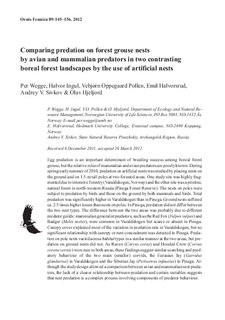| dc.contributor.author | Wegge, Per | |
| dc.contributor.author | Ingul, Halvor | |
| dc.contributor.author | Pollen, Vebjørn Oppegaard | |
| dc.contributor.author | Halvorsrud, Emil | |
| dc.contributor.author | Sivkov, Andrey V. | |
| dc.contributor.author | Hjeljord | |
| dc.date.accessioned | 2013-01-14T12:49:57Z | |
| dc.date.available | 2013-01-14T12:49:57Z | |
| dc.date.issued | 2012 | |
| dc.identifier.citation | Wegge, P., Ingul, H., Pollen, V. O., Halvorsrud, E., Sivkov, A. V., & Hjeljord, O. (2012). Comparing predation on forest grouse nests by avian and mammalian predators in two contrasting boreal forest landscapes by the use of artificial nests. Ornis Fennica, 89, 145-156. | no_NO |
| dc.identifier.uri | http://hdl.handle.net/11250/134552 | |
| dc.description | The article can also be located on the Ornis Fennica webpage: http://www.ornisfennica.org/index.htm | no_NO |
| dc.description.abstract | Egg predation is an important determinant of breeding success among boreal forest
grouse, but the relative roles ofmammalian and avian predators are poorly known. During
spring/early summer of 2010, predation on artificial nests was studied by placing nests on
the ground and on 1.5-m tall poles at two forested areas. One study site was highly fragmented
due to intensive forestry (Varaldskogen, Norway) and the other site was a pristine,
natural forest in north-western Russia (Pinega Forest Reserve). The nests on poles were
subject to predation by birds and those on the ground by both mammals and birds. Total
predationwas significantly higher inVaraldskogen than in Pinega. Ground nests suffered
ca. 2.5 times higher losses than nests on poles. In Pinega, predation did not differ between
the two nest types. The difference between the two areas was probably due to different
predator guilds:mammalian generalist predators, such as theRed Fox (Vulpes vulpes) and
Badger (Meles meles), were common in Varaldskogen but scarce or absent in Pinega.
Canopy cover explained most of the variation in predation rate in Varaldskogen, but no
significant relationship with canopy or nest concealment was detected in Pinega. Predation
on pole nests varied across habitat types in a similarmanner at the two areas, but predation
on ground nests did not. As Raven (Corvus corax) and Hooded Crow (Corvus
corone cornix)were rare in both areas, these findings suggest similar searching and predatory
behaviour of the two main (smaller) corvids, the Eurasian Jay (Garrulus
glandarius) in Varaldskogen and the Siberian Jay (Perisoreus infaustus) in Pinega. Although
the study design allowed a comparison between avian andmammalian nest predators,
the lack of a clearer relationship between predation and certain variables suggests
that nest predation is a complex process involving components of predator behaviour. | no_NO |
| dc.language.iso | eng | no_NO |
| dc.publisher | Suomen lintutieteellinen yhdistys | no_NO |
| dc.subject | egg predation | no_NO |
| dc.subject | grouse | no_NO |
| dc.title | Comparing predation on forest grouse nests by avian and mammalian predators in two contrasting boreal forest landscapes by the use of artificial nests | no_NO |
| dc.type | Journal article | no_NO |
| dc.type | Peer reviewed | no_NO |
| dc.subject.nsi | VDP::Mathematics and natural science: 400::Zoology and botany: 480 | no_NO |
| dc.source.pagenumber | 145-156 | no_NO |
| dc.source.volume | 89 | no_NO |
| dc.source.journal | Ornis Fennica | no_NO |
